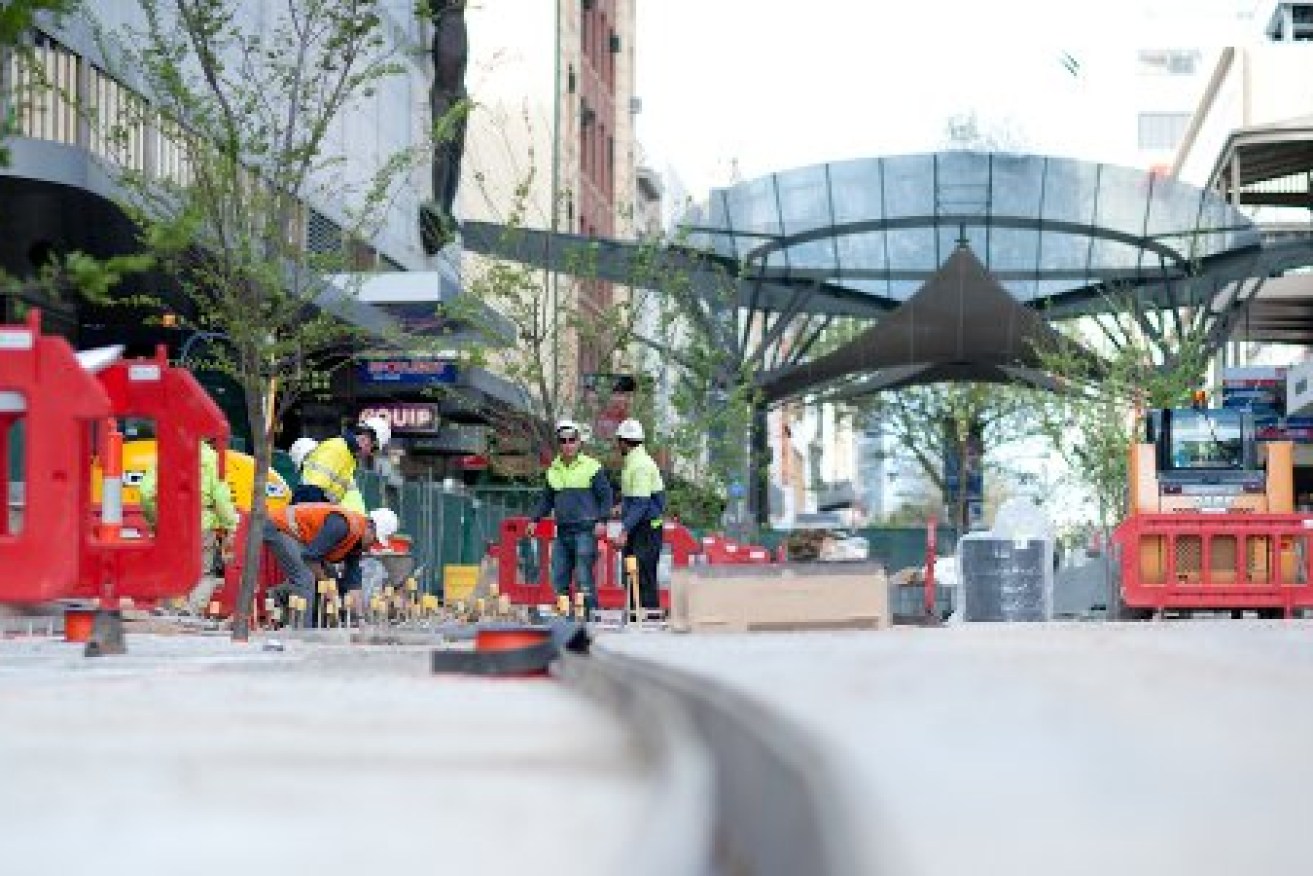“Boring, repetitious, dreary”: the Mall or the debate?


The Rundle Mall redevelopment: can we at least wait for it to be finished before we tear it apart? Photo: Nat Rogers/InDaily
The quote in the heading doesn’t refer to the Rundle Mall redevelopment, underway this year.
It’s how an outspoken city councillor once described the 1974 design for the original Mall – but it could be a summary of the standard of debate in Adelaide about urban design.
The new Mall isn’t even half completed, and we’re already tearing it apart.
The question isn’t whether this particular design is terrible – it’s whether we’ve been happy with any design, ever.
Sunday Mail columnist Peter Goers has taken a look at the half-finished Mall and pronounced it to be “barbaric, hideous, bare, ugly and ghastly”, the “most impersonal, user-unfriendly public space in Australia – possibly the world”.
His critique has deep echoes of the past.
Back in the early 1970s, the idea of closing Rundle Street to traffic was the subject of seemingly interminable hand-wringing.
For years we pondered, and worried, and retreated to positions of perceived self-interest.
In echoes of our modern debate about the influence of the motor car on the liveability of our city, shopkeepers were determined that closing the street to cars would destroy trade.
Boosters for the pedestrian Mall, such as Don Dunstan, believed cars were discouraging pedestrians from lingering and enjoying Adelaide’s retail heart.
Sound familiar?
Adelaide journalist Max Clements, writing in The Canberra Times on 3 July 1974, describes the designers’ vision for the Mall – a description which will sound very familiar to students of contemporary Adelaide’s “vibrancy” agenda.
“Their concept is for the mall to have fountains, art displays, sculpture, trees and outdoor cafes and bistros,” Max wrote.
“Nearly 70 trees, mostly deciduous, would soften kerbless granite paving…
“Stalls for weekend art and craft showings would he raised above pavement level so they could double as seats or occasional display facilities during the week.”
That sounds suspiciously like a pop-up concept.
Max goes on, though, to describe the council’s deep misgivings about the design.
“Councillor John Chappell, who is also an Adelaide architect of note, was so unimpressed with the design that he labelled it boring, repetitious, monumental and dreary. As if he had not fully got his message across, he added that, environmentally, it was an absolute disaster.
“In the wash-up, the council advanced so far as to reaffirm that a mall should be built, but did not vote to accept the design of the consultants.”
How very Adelaide. Something must be done – but not this!
There are more shadows of the present in this 1974 report – even a hip young council leader, who believes in “people” over “cars”.
Max writes: “It will be interesting to hear the on-the-job views on the mall of Adelaide’s new city planner, trendy 31-year-old Michael Llewellyn-Smith, at present deputy city planner for the City of Sydney. From his Sydney office, he already has slated his firm view that cities are for people, not cars. But on the Rundle Street Mall he had 20c each way. Rundle Street should be transformed into a mall, he said, ‘if most store owners and shopkeepers are in favour of it’.”
Llewellyn-Smith is now one of the elected council members, and a supporter of the Mall redevelopment.
All of this shows – depressingly – that some things never seem to change in Adelaide.
Wouldn’t it be nice if we stopped taking set-piece positions on issues of urban design and development, break out from the interminable either/or, and consider the possibility of new ways of doing and seeing things?
Why, for example, can’t we consider the idea that greater urban density and heritage protection can go hand in hand? As an example, we can look at a suburb such as North Adelaide – which has both considerable density, compared to surrounding suburbs, and an excellent collection of heritage buildings.
Does the debate about planning have to be constantly blown out into a battle between ‘evil’ developers and ’embattled’ communities? Might we search a little harder for the space where commercial realities and community desires intersect?
Can we find a way to balance the needs and wants of multiple road users – those in private cars, on public transport and riding their bikes?
And can we – at least – wait until new projects, such as the mall redevelopment, are completed before rushing to judgement?
We might also remember that the original Mall – when eventually completed in 1976 after years of fussing and fretting – became one of the most successful retail strips in Australia.
Can we find room in our imagination for the possibility that the new Mall might be a success?




